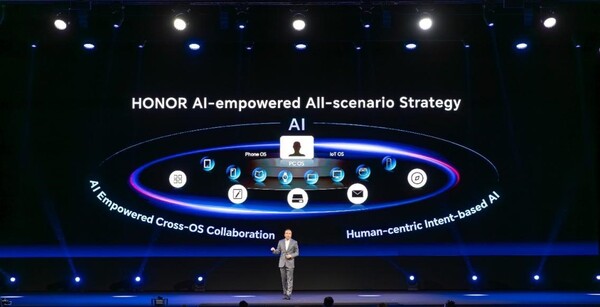By Gao Qiao
Global smartphone shipments reached 1.14 billion units in 2023, said a recent report released by the international market research firm Canalys. Three Chinese brands - Xiaomi, OPPO, and Transsion - made it into the top five.
As China's smartphone industry matures, an increasing number of Chinese brands are venturing into overseas markets and gaining recognition from consumers worldwide.
At the recently held Mobile World Congress 2024, the Magic 6 Pro smartphone developed by Chinese tech company Honor garnered attention for its AI-enabled eye tracking technology, which allows users to control the device with eye movements.

Earlier, Honor unveiled the foldable smartphone Magic V2 with a folded thickness of just 9.9mm, similar to that of regular phones - a first in the foldable smartphone segment.
Riding the wave of the prosperity of mobile internet around the world and relying on the robust development of its smartphone industry, China has become the world's largest producer and exporter of mobile phones.
In the first two months of 2024, China exported mechanical and electrical products worth 2.22 trillion yuan (about $308.41 billion), up 11.8 percent year on year, accounting for 59.1 percent of its total exports. A total of 123.7 million mobile phones were exported during this period.
Canalys research manager Liu Yixuan said that currently, overseas markets, especially emerging ones, are crucial growth avenues for Chinese smartphone brands, with different brands focusing on their specific regions.
Xiaomi has made comprehensive efforts in the Middle East, Africa, Europe, and Latin America. OPPO and Vivo's overseas markets are mainly in the Asia-Pacific region. Honor focuses on Europe, Latin America, and the Middle East. Seeking overseas business growth is a strategic choice for many Chinese mobile phone brands.

What has enabled Chinese smartphone brands to develop in overseas markets?
In an interview with People's Daily, Bai Ming, a researcher at the Chinese Academy of International Trade and Economic Cooperation summarized advantages of Chinese smartphones.
He said Chinese smartphones have high cost-performance and feature designs that cater to overseas markets. Besides, Chinese smartphones and communication technologies are well matched thanks to China's infrastructure cooperation with many countries in telecommunications.
He said China's domestic smartphone industry has diverse product segments, a complete industrial chain, and frequent product iteration, so products that have weathered intense domestic competition would become competitive in overseas markets.
Take Honor smartphones as an example. Statistics from Canalys and Counterpoint showed that in the fourth quarter of 2023, less than two years after re-entering overseas markets, Honor ranked among the top five in terms of sales in Europe, the Middle East, and Latin America. The Chinese smartphone manufacturer has also established a global sales and service network covering over 70 countries and regions.

In an interview, George Zhao, CEO of Honor Device Co., Ltd., said that Honor maintained rapid growth amid the overall downturn in the global smartphone market by adhering to high-quality development, targeting users' demands, strengthening global industrial chain cooperation, and transforming technological innovation into market-demanded products.
Additionally, Honor emphasizes localized strategies in different regional markets. It provides product portfolios tailored to local users, and strengthens communication and collaboration with local partners, so as to better enhance user experience.
According to recent data released by the international market research firm IDC, Chinese smartphone brands have consistently increased their market share of high-end smartphones with prices over $600 in the past five years. In 2023, their market share in this segment reached 27.4 percent, up 3.7 percentage points from 2022 and doubling that in 2019.
"As AI technology flourished in 2023, a new round of technological revolution and industrial transformation emerged, bringing both new opportunities and challenges for the global smart terminal market," said Zhao.
According to him, Honor has invested over 10 billion yuan in AI research and development, obtained more than 2,000 AI-related patents, and applied platform-level AI technology to promote innovations such as cross-device collaboration and next-generation intent recognition in smartphones.
"With the emergence of more and more application scenarios and demands, as well as the development of AI and other new technologies, the iteration of Chinese smartphones in terms of functionality and technology is worth the wait," said Bai.


